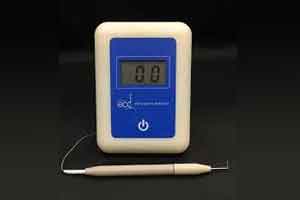- Home
- Editorial
- News
- Practice Guidelines
- Anesthesiology Guidelines
- Cancer Guidelines
- Cardiac Sciences Guidelines
- Critical Care Guidelines
- Dentistry Guidelines
- Dermatology Guidelines
- Diabetes and Endo Guidelines
- Diagnostics Guidelines
- ENT Guidelines
- Featured Practice Guidelines
- Gastroenterology Guidelines
- Geriatrics Guidelines
- Medicine Guidelines
- Nephrology Guidelines
- Neurosciences Guidelines
- Obs and Gynae Guidelines
- Ophthalmology Guidelines
- Orthopaedics Guidelines
- Paediatrics Guidelines
- Psychiatry Guidelines
- Pulmonology Guidelines
- Radiology Guidelines
- Surgery Guidelines
- Urology Guidelines
New Electronic Cavity Detection Device (ECD) for Detecting dental Cavities Early

Imagine if dentists could find clear signs of tooth decay long before dental lesions turn into cavities and without using X-rays. Produced by Ortek Therapeutics, The Electronic Cavity Detection Device (ECD) is a patented lightweight tabletop device designed as an aid for dental professionals to diagnose and monitor dental cavities in the biting surfaces of molars and premolars.
In clinical trials, the ECD system detected the earliest forms of mineral loss in enamel well before an actual cavity was formed. These pre-cavity lesions were discovered without exposure to radiation from x-rays. The ECD was developed in the Division of Translational Oral Biology at Stony Brook University and exclusively licensed to Ortek from The Research Foundation of State University of New York.The ECD was up to 96% accurate in detecting microscopic pre-cavity enamel lesions in the biting surfaces of molars and premolars. There were no false negative readings in either study.
The ECD was developed by a team of researchers led by Israel Kleinberg, DDS, PhD, DSc, Distinguished Professor in the Department of Oral Biology and Pathology, and Director of the Division of Translational Oral Biology at Stony Brook. "We believe the ECD is a new paradigm in oral care," said Dr. Kleinberg. "This device will help dental professionals diagnose and monitor pre-cavitated lesions in enamel that cannot be detected by x-rays. This will enable the dental practitioner to design an appropriate treatment plan that could include minimally invasive care."
A battery-powered device, the ECD uses electrical conductance to accurately diagnose and monitor enamel lesions. Tooth enamel is electrically non-conductive unless breached by fracture or demineralization. When teeth begin to lose minerals, dentinal fluid from within the tooth percolates through the breached enamel site and enables the ECD to complete its electrical circuit. The ECD features a handpiece with a novel probe tip and can precisely measure the amount of dentinal fluid in the pits and fissures of molars and premolars. The more fluid the ECD detects, the greater the severity or extent of the cavity or pre-cavity enamel lesion. This data is numerically displayed on the ECD base unit.
Electronic Cavity Detection (ECD) System uses electrical conductance to diagnose and monitor enamel lesions on the biting surfaces of molars and premolars. The mineral loss in tooth enamel is a significant change that leads to the development of cavities. The battery-powered ECD detects this early mineral loss before a cavity form. In clinical trials conducted through Stony Brook School of Dental Medicine, the ECD was up to 96 percent accurate in detecting microscopic pre-cavity enamel lesions. Lead researcher Israel Kleinberg, DDS, Ph.D., DSc, believes that the device will emerge as a new paradigm in oral health care and may help dentists diagnose and monitor pre-cavitated lesions in enamel that cannot be detected by X-rays.

Disclaimer: This site is primarily intended for healthcare professionals. Any content/information on this website does not replace the advice of medical and/or health professionals and should not be construed as medical/diagnostic advice/endorsement or prescription. Use of this site is subject to our terms of use, privacy policy, advertisement policy. © 2020 Minerva Medical Treatment Pvt Ltd